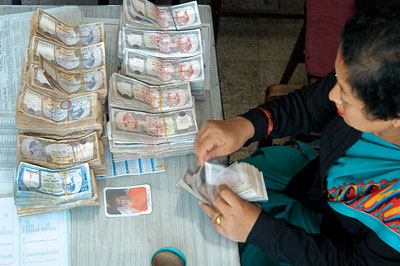 MIN RATNA BAJRACHARYA |
In Nepal, political analysis often overshadows economic analysis. There is a deficiency of accurate and unbiased economic data, and whatever is available is usually from a development sector perspective that is inadequate for the private sector. Nepal Economic Forum's NEFport is meant to bridge this gap, with the second issue published in April this year.
On the global front, the international economy showed signs of recovery as prudent fiscal and monetary measures taken by governments and central banks helped shake off the effects of the global financial crisis. Nationally, the economy of Nepal experienced some major setbacks due to the bleak political outlook, coupled with a significant downturn in the financial sector. The key stories and business highlights of the year included the liquidity crisis, capital flight, balance of payments, real estate market, gold imports, and inflation.
The liquidity crisis deepened after Dasain 2009, with financial institutions unable to access ready pools of cash. It was then that capital flight was assessed. NEFport reveals that 'USD 100 million (over Rs 8 billion) from Nepal found its way into banks in Hong Kong during the first five months of the fiscal year'. Similarly, 'gold imports crossed 14 tons in the first seven months of the fiscal year 2009/10'. The Nepal Rastra Bank banned the import of gold from mid-January, on the grounds that gold imported into Nepal was being smuggled back into India. The bank feared excessive spending of foreign reserves on gold imports.
Inflation soared to 12 per cent in the first seven months of the current fiscal year, increasing the price of sugar and related products by almost 80 per cent. The government cut import duties and the Agricultural Reform Fee on raw materials for the edible oils industry, and also pledged a 50 per cent VAT refund, in order to curb inflation.
The real estate market in Nepal continued to boom, in sharp contrast to the serious slump in land and property markets globally. Land prices are estimated to have risen by close to 200 per cent in the past three years. Concerned that the real estate bubble would burst, Nepal Rastra Bank decided to impose a cap on financial institutions' loan exposure to the real estate sector. Following this move, the lending rates of financial institutions arbitrarily increased to 15-16 per cent, up from 10 per cent.
The negative balance of payments, NEFport noted, reflected a 'heavy reliance on imports for goods including gold, petroleum products and vehicles, coupled with a decline in foreign exports and low overall economic growth. The slowdown in remittance growth coupled with an increase in imports has led to a BOP deficit of around Rs. 19.7 billion, compared to a Rs. 28.53 billion surplus the previous year'.
NEFport concedes that the dominating influence of politics will make it difficult for the economy to buck the trend. Nevertheless, it is hoped the appointment of Yuvraj Khatiwada as the new governor of Nepal Rastra Bank will accelerate a much-needed macroeconomic clean up and enforce stronger financial discipline.
Inflationary pressures remain a distinct possibility because, as international growth picks up, Nepal too will be affected by the concomitant rise in oil and commodity prices. There will be no major changes in foreign aid. Nepal is likely to make use of the IMF's standby credit facility in order to address its short-term macroeconomic imbalances. Capital markets will show signs of improvement, and the NEPSE index will rise as the end of the fiscal year approaches.
For further information, visit www.nepaleconomicforum.org


